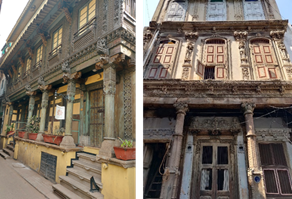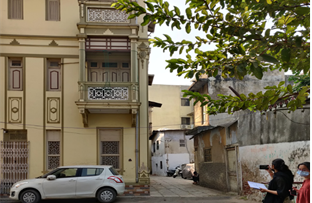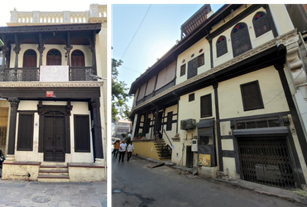Residential Pols of the Walled City Ahmedabad: A brief review of its significance, condition and way
- maithilee Sagara
- Apr 18, 2023
- 4 min read
- Manvita Baradi and Anurag Anthony
April 2023
The Indian sub-continent is endowed with a rich and vast heritage repository contributing significantly to the global heritage stock. Cultural heritage, as defined by UNESCO, is the legacy of physical artefacts and intangible attributes of society inherited from past generations. According to the 1972 Convention, cultural heritage includes artefacts, monuments, groups of buildings and sites or museums with diverse values including symbolic, historic, artistic, aesthetic, scientific and so on (Cultural Heritage, UNESCO, 2022). Etymologically, the term refers to monuments inherited from previous generations.
Indian cultural heritage, shaped by its rich historical background and geo-political expanse, is diverse and includes tangible forms such as monuments and buildings as well as traditional art forms and craftsmanship. There are around 3,650 monuments that are protected by the Archaeological Survey of India (ASI) and several thousand are in the custody of Archaeology Departments under state governments. UNESCO declared 25 Indian monuments to be world heritage monuments.
Ahmedabad: A World Heritage City
Ahmedabad is the first Indian city to receive World Heritage City status in 2017. The character of the walled city is defined by the pols (historic neighbourhoods) of Ahmedabad. The outstanding universal value (OUV) of the walled city of Ahmedabad is demonstrated through its intricately adorned vernacular architecture, representing unity and solidarity through diverse historic periods, occupations, communities, and religions. The diversity in architectural style, plans and materials such as the famous ornately carved wooden facades of the buildings showcase elements from mixed faith and their influences.
While the great monumental structures mark the milestone of city and its evolution and history, the vernacular heritage tells the tales of the original Amdavadi society, their tradition, culture and mirrors the diverse facets of city’s socio-economic stature.
These neighbourhoods are usually distinguished by their building style, pols streets, chowks, chabutaras, tankas and pol gates.
Figure 1: Examples of restored havelis
Reflecting on the conditions of Pols at present
The historic city of Ahmedabad has witnessed an archetypal organic growth over time. Globalisation and the steady rise of commercialisation in Ahmedabad, is leading to an irregular and uncontrolled urbanisation in this 600-year-old historic walled city, which has a consequential effect on the overall character. In addition, the growing desire for better and modern infrastructure, better amenities and an overall improved quality of life are resulting in the current trends in the modernisation of the traditional built-up area. Therefore, the pols are undergoing a significant transition, to an extent that the city is losing much of its original cultural context, which distinguished Ahmedabad from other cities.

Figure 2: Example of modifications in heritage structures
Originally, the pols were socially homogenous in character (for instance - Tankshal Pol housed workers and families of Mint, Dhobi-ni-Pol housed occupants in washing profession, Kansara Pol housed coppersmiths and so forth). At present, living in these traditional neighbourhoods is challenged in multifarious ways which also instigate the pol residents to out-migrate for a better lifestyle and cheaper rent in the walled city is attracting in-migrants.
Changing demography, socio-economic condition of the urban population and aspiration for modernisation coupled with a lack of awareness towards urban heritage resulted in an uncontrolled change in land use, increasing traffic volume, and increasing encroachment which is subsequently changing the historic character of these traditional pols.

Figure 3: Example needing immediate conservation efforts
UMC’s role in preserving the Walled City living heritage (Pols)
Ahmedabad’s inscription by UNESCO as a World Heritage City in 2017, brought back the attention to the pols and other cultural assets of the city. Consequently, the Ahmedabad Municipal Corporation (AMC) commissioned the Urban Management Centre (UMC) to prepare Heritage Zonal Plans (HZP) of the six municipal wards constituting the walled city. The HZPs aim to strengthen the cultural heritage by reviving the character of the heritage zones space and to improve the quality of life of the locals through appropriate design and management measures. UMC has been intensively engaged with AMC since 1997 on various studies, projects and policy support for managing the city’s heritage.
As a part of the HZP, UMC prepared inclusive mobility plan to decongest the walled city, urban design plans for public spaces, signage policy, landscape toolkit and improvement plans for heritage precincts, including pols. To support conservation efforts by heritage property owners, UMC also prepared building guidelines, focusing on the do’s and don’ts repair and renovation in the walled city. Aligning with the Ahmedabad walled city’s OUV, UMC undertook the arduous task of plotting ‘heritage buildings with wooden facades’ and conceptualized a policy for the conservation of timber architecture in the walled city.
UMC and its partner the Theatre Media Centre (TMC) has been performing street plays in the pols of the walled city. These plays have been a popular medium of communication to garner support of homeowners in their conservation efforts since decades.
While change is only constant, and conservation is a part of development the overall intention is to promote sustainable and inclusive urban development by conserving one of the essential part of urban heritage of Ahmedabad city.
*Team members who contributed to the efforts at Urban Management Centre: Munindra Joshi, Nikita Popat, Mansi Sureka, Purva Patel, Chimu George, and Shashwat Sethi.
About the Authors
Manvita Baradi

Manvita Baradi is the Founder & Director of the Urban Management Centre. For almost 3 decades, she has been one of India’s leading voices advocating for the development of better cities.
Anurag Anthony

Anurag Anthony is the Chief Technical Officer at Urban Management Centre. He is an expert in local government management across sectors including heritage management, urban design, water-sanitation and community engagement.







Comments